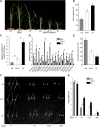The OsGSK2 Kinase Integrates Brassinosteroid and Jasmonic Acid Signaling by Interacting with OsJAZ4
- PMID: 32586913
- PMCID: PMC7474301
- DOI: 10.1105/tpc.19.00499
The OsGSK2 Kinase Integrates Brassinosteroid and Jasmonic Acid Signaling by Interacting with OsJAZ4
Abstract
The crosstalk between brassinosteroid (BR) and jasmonic acid (JA) signaling is crucial for plant growth and defense responses. However, the detailed interplay between BRs and JA remains obscure. Here, we found that the rice (Oryza sativa) Glycogen synthase kinase3 (GSK3)-like kinase OsGSK2, a conserved kinase serving as a key suppressor of BR signaling, enhanced antiviral defense and the JA response. We identified a member of the JASMONATE ZIM-domain (JAZ) family, OsJAZ4, as a OsGSK2 substrate and confirmed that OsGSK2 interacted with and phosphorylated OsJAZ4. We demonstrated that OsGSK2 disrupted the OsJAZ4-OsNINJA complex and OsJAZ4-OsJAZ11 dimerization by competitively binding to the ZIM domain, perhaps helping to facilitate the degradation of OsJAZ4 via the 26S proteasome pathway. We also showed that OsJAZ4 negatively modulated JA signaling and antiviral defense and that the BR pathway was involved in modulating the stability of OsJAZ4 protein in an OsCORONATINE INSENSITIVE1-dependent manner. Collectively, these results suggest that OsGSK2 enhances plant antiviral defenses by activating JA signaling as it directly interacts with, phosphorylates, and destabilizes OsJAZ4. Thus, our findings provide a clear link between BR and JA signaling.
© 2020 American Society of Plant Biologists. All rights reserved.
Figures









Comment in
-
OsGSK2 Integrates Jasmonic Acid and Brassinosteroid Signaling in Rice.Plant Cell. 2020 Sep;32(9):2669-2670. doi: 10.1105/tpc.20.00531. Epub 2020 Jul 14. Plant Cell. 2020. PMID: 32665308 Free PMC article. No abstract available.
Similar articles
-
Rice stripe virus suppresses jasmonic acid-mediated resistance by hijacking brassinosteroid signaling pathway in rice.PLoS Pathog. 2020 Aug 31;16(8):e1008801. doi: 10.1371/journal.ppat.1008801. eCollection 2020 Aug. PLoS Pathog. 2020. PMID: 32866183 Free PMC article.
-
OVATE Family Protein 8 Positively Mediates Brassinosteroid Signaling through Interacting with the GSK3-like Kinase in Rice.PLoS Genet. 2016 Jun 22;12(6):e1006118. doi: 10.1371/journal.pgen.1006118. eCollection 2016 Jun. PLoS Genet. 2016. PMID: 27332964 Free PMC article.
-
The receptor-like cytoplasmic kinase OsSTRK1 regulates brassinosteroid signaling by phosphorylating OsGSK2.Cell Rep. 2025 Apr 22;44(4):115569. doi: 10.1016/j.celrep.2025.115569. Epub 2025 Apr 11. Cell Rep. 2025. PMID: 40220291
-
Jasmonate biosynthesis and signaling in monocots: a comparative overview.Plant Cell Rep. 2013 Jun;32(6):815-27. doi: 10.1007/s00299-013-1400-y. Epub 2013 Mar 2. Plant Cell Rep. 2013. PMID: 23455708 Review.
-
Jasmonate passes muster: a receptor and targets for the defense hormone.Annu Rev Plant Biol. 2009;60:183-205. doi: 10.1146/annurev.arplant.043008.092007. Annu Rev Plant Biol. 2009. PMID: 19025383 Review.
Cited by
-
Involvement of PtPHR1 in phosphates starvation-induced alkaloid biosynthesis in Pinellia ternata (Thunb.) Breit.Front Plant Sci. 2022 Aug 10;13:914648. doi: 10.3389/fpls.2022.914648. eCollection 2022. Front Plant Sci. 2022. PMID: 36035724 Free PMC article.
-
Genome-Wide Analysis of the Gene Structure, Expression and Protein Interactions of the Peach (Prunus persica) TIFY Gene Family.Front Plant Sci. 2022 Feb 17;13:792802. doi: 10.3389/fpls.2022.792802. eCollection 2022. Front Plant Sci. 2022. PMID: 35251076 Free PMC article.
-
The CALCINEURIN B-LIKE 4/CBL-INTERACTING PROTEIN 3 module degrades repressor JAZ5 during rose petal senescence.Plant Physiol. 2023 Sep 22;193(2):1605-1620. doi: 10.1093/plphys/kiad365. Plant Physiol. 2023. PMID: 37403193 Free PMC article.
-
A fijivirus capsid protein hijacks autophagy degrading an ω-3 fatty acid desaturase to suppress jasmonate-mediated antiviral defence.Plant Biotechnol J. 2025 Jul;23(7):2891-2907. doi: 10.1111/pbi.70119. Epub 2025 May 5. Plant Biotechnol J. 2025. PMID: 40322866 Free PMC article.
-
A rice DELLA protein OsSLR1 positively regulates rice resistance to southern rice black-streaked dwarf virus infection.BMC Plant Biol. 2025 Mar 26;25(1):379. doi: 10.1186/s12870-025-06394-0. BMC Plant Biol. 2025. PMID: 40133821 Free PMC article.
References
-
- Cai Z., Liu J., Wang H., Yang C., Chen Y., Li Y., Pan S., Dong R., Tang G., Barajas-Lopez JDE.D., Fujii H., Wang X.(2014). GSK3-like kinases positively modulate abscisic acid signaling through phosphorylating subgroup III SnRK2s in Arabidopsis. Proc. Natl. Acad. Sci. USA 111: 9651–9656. - PMC - PubMed
-
- Chini A., Fonseca S., Chico J.M., Fernández-Calvo P., Solano R.(2009). The ZIM domain mediates homo- and heteromeric interactions between Arabidopsis JAZ proteins. Plant J. 59: 77–87. - PubMed
-
- Chini A., Fonseca S., Fernández G., Adie B., Chico J.M., Lorenzo O., García-Casado G., López-Vidriero I., Lozano F.M., Ponce M.R., Micol J.L., Solano R.(2007). The JAZ family of repressors is the missing link in jasmonate signalling. Nature 448: 666–671. - PubMed
Publication types
MeSH terms
Substances
Supplementary concepts
LinkOut - more resources
Full Text Sources

